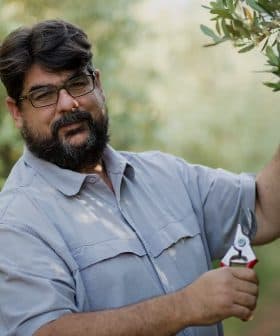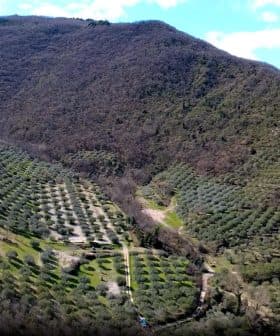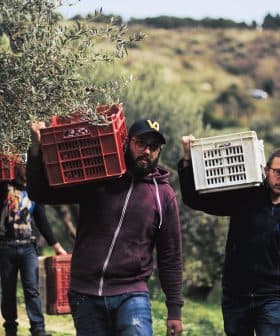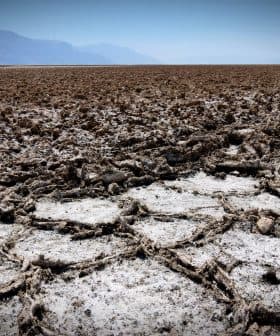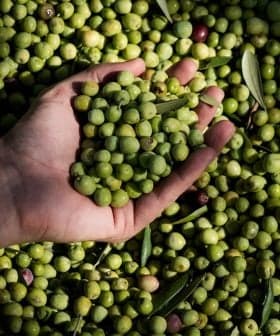Meet the Genoese Couple Cultivating Traditional Italian Olives in Uruguay
Maria Vittoria Saccarello and Domenico Bruzzone decided to start an olive growing project in Uruguay after retiring from their humanitarian work worldwide. Despite facing challenges like weather setbacks and labor shortages, their company, Pique Roto, has seen success producing high-quality olive oils and table olives, and they plan to expand into oleotourism to educate consumers about their products.
After more than four decades of traveling the world and working on humanitarian aid and development projects, Maria Vittoria Saccarello and Domenico Bruzzone wanted to pursue a new project after retirement.
Instead of returning to their native Genoa from their last post in West Africa (after Vienna, Central America, West Africa, Bolivia and Pakistan), they began searching for a place to settle in Latin America, with an operational agenda.
See Also:Producer Profiles“Our first assignment outside of Europe was on the Mexican border with Guatemala,” Bruzzone said. “Latin America made a lasting impression on us.”
At the same time, the couple became passionate about olive growing partially due to their upbringing in northern Italy and their experiences working with the Italian government to plant olive trees in Egypt, Lebanon and Pakistan.

Domenico Bruzzone (third from right) and Saccarello (second from left) planting olive trees at the experimental Bari Chacwal station in Pakistan in 2014. (Photo: Pique Roto)
Eventually, the couple identified Uruguay as a suitable location for their new project, citing the dollarized economy, political stability, language, cultural similarities to Italy and olive-friendly terroir.
“We did some research about the necessary size for the company to become economically self-sustaining and make the investment profitable,” Saccarello said.
The couple eventually bought a 40-hectare plot of land in the central department of Florida, 100 kilometers northeast of Montevideo, Uruguay’s capital, in 2012. They planted their first olive trees in 2014 and produced olive oil for the first time in 2019.

Pique Roto started planting 30 hectares of olive trees in 2012. (Photo: Pique Roto)
While Arbequina, Picual and Coratina are the dominant varieties in Uruguay, Saccarello and Bruzzone opted to import traditional Italian varieties, including Taggiasca, Frantoio, Leccino and Pendolino, from a well-known Italian nursery.
“When we first planted, nobody knew Taggiasca, Frantoio, Leccino and Pendolino in Uruguay,” Saccarello said. “So the agronomist asked us to plant Arbequina to compare its yields with the Italian varieties.”
After several setbacks, including half of the Arbequina trees dying in the first year after their roots failed to take hold, and a tornado which knocked-out some 500 trees in the grove, inspiring the brand name, Pique Roto, or broken stick, the couple discovered that the Italian varieties thrived in Uruguay, especially Taggiasca and Pendolino.

Saccarello inspects the groves ahead of the harvest, which typically begins in late March and ends in mid-June. (Photo: Pique Roto)
“The northern Italian varieties have a greater affinity than the Spanish varieties [Arbequina and Picual] because [Florida] has a rainier, almost cold climate,” Bruzzone said.
Combining conventional varieties and Italian imports also resulted in a staggered harvest.
“It starts in late March or early April with Arbequina, then it goes to Leccino, depending on the speed of the olive’s ripening cycle, continues with Frantoio and ends with Taggiasca in mid-June,” Bruzzone said. “This allows the harvest to be programmed and is harmonized if there is no excess rain.”
Saccarello added that other producers usually harvest everything early to avoid the winter humidity and increased potential for the olives to develop anthracnose, resulting in defects in the oil.
Even though one-fifth of their trees are Arbequina, Bruzzone and Saccarello focus mainly on the Italian varieties, and were initially selling Arbequina extra virgin olive oil in bulk. “With the sale of Arbequina, we generally finance the entire harvest,” Bruzzone said.
The couple produces two extra virgin olive oils: Tosca, a Tuscan field blend of Frantoio, Leccino and Pendolino, and a Taggiasca monovarietal.
“We do not make Tosca in the mill. In one year, Tosca might have more Frantoio, making it more fruity and green, spicier and more bitter,” Saccarello said. “Another year, it might have more Leccino, providing an interesting sweet note. Tosca is a product of what the land gives us.”
On the other hand, the Taggiasca monovarietal is a unique late-season olive oil and yielded one of four first-place awards at the 2024 Mario Solinas Awards, hosted in Uruguay.

Saccarello and her agronomist (left) inspect the olive groves with a delegation from the International Olive Council and Uruguayan Olive Association (Asolur). (Photo: Pique Roto)
“Obviously, this motivates us a lot,” Bruzzone said. “It is recognition for ten years of hard work.”
He added that the award was especially gratifying after the cloudy and rainy 2024 harvest, which made picking the olives and other tastes in the groves very intense.
“The amount of rain was tremendous; it hardly stopped,” Bruzzone said. “We also worried about the quality of the oil since the olives had so little sunlight exposure leading up to picking.”
In the mill, Saccarello said she had to regulate the calibration of the decanter, the malaxing speed and the times every day due to the amount of water in the olives to prevent the paste from becoming a watery emulsion.
Despite these challenges, Pique Roto harvested 193 metric tons of olives, significantly higher than the 53 tons harvested in 2023 during Uruguay’s historic drought.
Overall, preliminary harvest data from the private sector shows Uruguay produced 614 tons of olive oil in 2024, with Pique Roto as one of the few companies that saw production increase compared to 2023.
While the rain was the company’s main challenge in 2024, finding enough workers to undertake a manual harvest and work in the mill is always challenging.
Despite labor challenges, Saccarello said she prefers a manual harvest to a mechanical one since it allows her to control the amount of fruit brought to the mill.

Saccarello mills less than five tons of olives dily, allowing her to ensure high quality. (Photo: Pique Roto)
The company has Mori-Tem equipment capable of processing 500 kilograms per hour.
“The goal is to mill no more than five tons of olives each day because this amount allows us to have the maximum possible quality control,” she said.
Looking ahead to the 2025 harvest, Bruzzone and Saccarello anticipate a reasonably good harvest, estimating it will be between 150 and 170 tons of olives.
“There are plants loaded with fruit and plants that have nothing at all,” Saccarello said. “Anyway, we will see how the growth of the olives continues.”
Bruzzone and Saccarello said the company plans to introduce a Pendolino monovarietal brand after introducing their latest bivarietal, Sur, a blend of Arbequina and Coratina, the latter of which is common in Uruguay.

While most Uruguayan olive groves are located near the coast, the inland climate of Florida favors northern Italain varieties more adapted to the cold. (Photo: Pique Roto)
“We want to experiment with a Pendolino monovarial, which is somewhat rare in Italy, too,” Saccarello said.
“Pendolino is a very interesting tree that our agronomist is convinced should be expanded,” Bruzzone added. “It is a very strong oil, and the plant is majestic.”
Depending on how the oil turns out and the market reaction, the couple will decide whether to keep a significant amount of the batch or blend it into a tank with Tosca.
While olive oil production is their passion, Saccarello said the company’s key to success is introducing a range of products to the market, further developing those that show more appeal and doubling down on the ones that do.

The founders of Pique Roto believe producers must offer a range of olive products in the market. (Photo: Pique Roto)
“This is a very important economic complement for the plantation,” Bruzzone said.
Along with olive oil, the couple produces table olives in a brine with a traditional nine month treatment. Most table olives in Uruguay are imported from Argentina and treated with lye, resulting in a markedly different flavor profile.
“Almost all the olive’s nutritional elements, its organoleptic properties and probiotics are almost all lost [when treated in lye],” Bruzzone said.
Saccarello, who loves to cook in her free time, said the company also sells a range of olive pâté concocted in her laboratory overlooking the olive trees.
“When we first started with the table olives, I noticed that there was no olive pâté in the market,” she said. “So I started making a line of products called ‘regional passions’ which are based on traditional recipes of the Mediterranean diet from the different regions of Italy.”
“We are currently working on two products before introducing them to the market,” she said. “Sometimes, they don’t immediately catch on, but most of the time, they do work out.”
Another aspect of the Uruguayan olive sector Pique Roto is working to enter is oleotourism.

Bruzzone believes that the best place to explain the extraordinary qualities of extra virgin olive oil is in the grove. (Photo: Pique Roto)
Bruzzone said oleotourism provides producers an excellent opportunity to educate consumers about extra virgin olive oil’s health benefits and sustainability while developing a willingness to pay.
“There is no better way to explain to the consumer about the merits of olive oil than a visit to a plantation where they can understand what this tree is, how it develops, how it is cared for and how much work that entails,” he said.
Since Pique Roto focuses its efforts on the domestic market — though the company has exported Arbequina in bulk before — Saccarello emphasized that it is necessary to bring Uruguayans to olive groves and explain the difference between local production and imports from large-scale Spanish, Italian and Argentine producers and bottlers.
“You have to show the consumer the olive tree and say, ‘see that tree, it is responsible for the three-liter bag-in-box you bought last week,’” she said, pointing out that it is more difficult to conceptualize what ten kilograms of olives looks like compared to a liter of oil. “This helps them understand,” she said.


